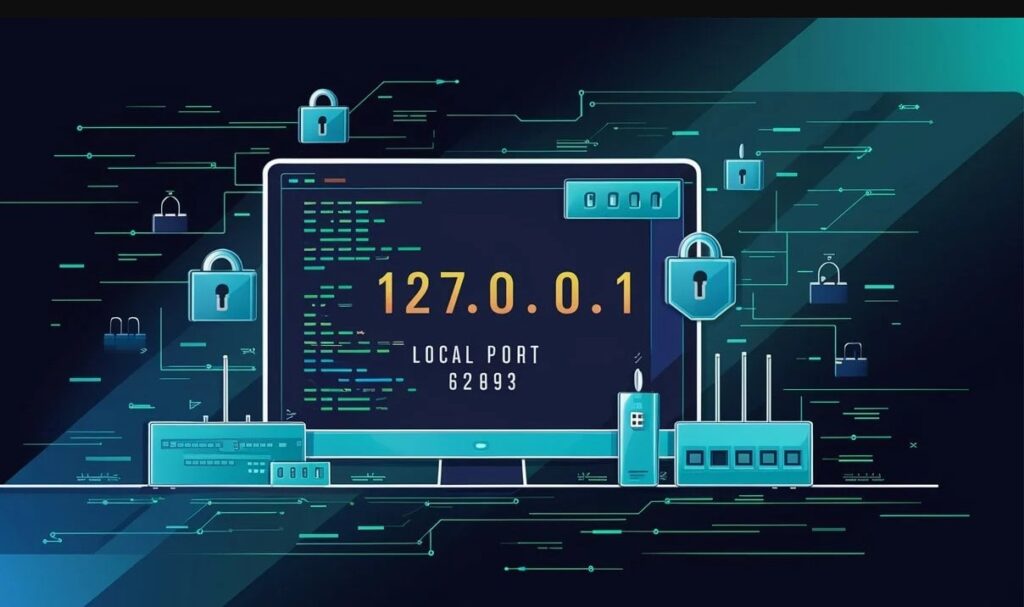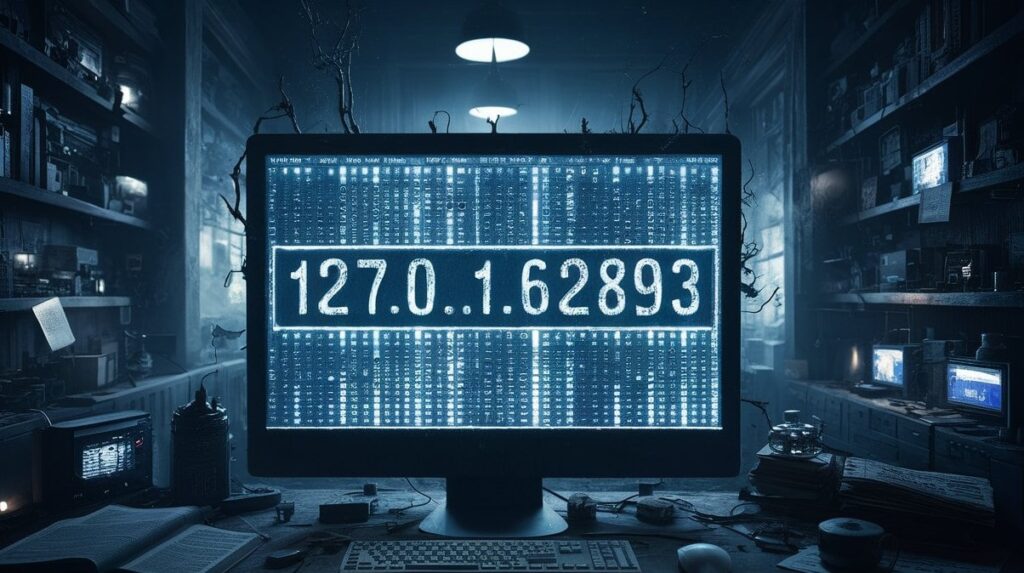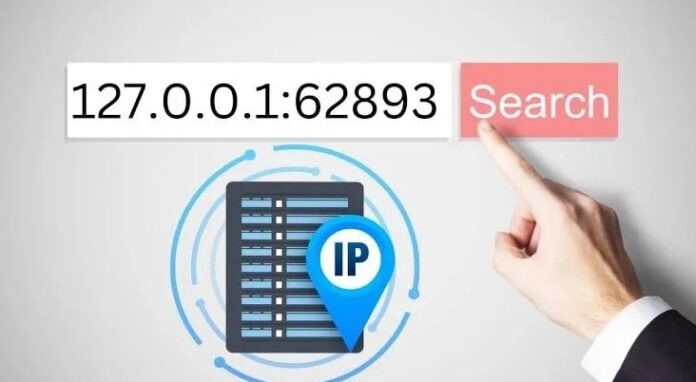The address “127.0.0.1:62893” denotes a high-numbered port (62893) and a local loopback IP (127.0.0.1). It frequently occurs when a program tests local services or communicates with itself in networking or software development situations.
It can be used, for instance, by a developer to simulate queries without the need for external servers in order to debug an API or online application. 62893 is a dynamically issued port that isn’t connected to any particular service. If it appears out of the blue, it can be a sign that a program—such as a debugging tool or local server—is running on your computer. Less frequently, it might be a sign of unwanted software running locally. Examining active processes guarantees safe use.
Table of Contents
What Is 127.0.0.1?
We must first examine the first section, 127.0.0.1, in order to begin comprehending “127.0.0.1:62893.” In Internet Protocol (IP) networking, this sequence stands for what is referred to as the loopback address. To put it another way, it’s like an address that points directly to your computer. A computer is sending data to itself whenever it transmits it to 127.0.0.1. Computers can test network connections using this address, which is reserved especially for the loopback function, without ever having to leave the system. Programmers and IT specialists regularly utilize this clever approach to verify that their network software is operating properly without the need for external devices or servers.
What Does 62893 Mean?
Let’s now concentrate on 62893, the second section. The port number is this. On a computer, ports are similar to doors; each is designated for a distinct function or application. When data is sent, it must travel to a specific port rather than merely your computer’s IP address. Imagine that 127.0.0.1:62893 is similar to delivering mail to an apartment building: the port represents the particular apartment where the parcel is dropped off, while the IP address represents the building. From 0 to 65535, port numbers are frequently utilized for a variety of purposes, such as managing emails, interacting with databases, and operating web servers. For short-term communication between systems or applications, port 62893 might be dynamically allocated.
Why Use the Loopback Address?

“Why do we even need an address like 127.0.0.1?” you may be asking yourself. The answer is straightforward: debugging and testing. Before releasing a program into a live network, developers frequently use this IP to make sure it is operating as planned on their computer. It is ideal for troubleshooting issues with web servers, databases, or even chat systems since it enables you to communicate with your system without leaving your local area.
For instance, you may configure your computer to run 127.0.0.1 if you’re creating a website. This enables you to view the website as though it were hosted online, despite the fact that it is only operating locally.
What Happens When You Visit 127.0.0.1:62893?
Imagine being online when all of a sudden your browser takes you to 127.0.0.1:62893. What’s going on?
In essence, your browser is attempting to use port 62893 to connect to a service that is operating on your machine. This could occur while using a tool that connects to a local service, a local web server, or an application that opens particular ports for communication. The most important lesson here is that your computer is always referred to by 127.0.0.1.
When working with technologies such as virtual machines, Docker containers, or even database systems, or when testing web apps locally, this URL may appear.
Common Uses of 127.0.0.1 and High Ports Like 62893
When working with localhost, 127.0.0.1 is often what you’ll see. The loopback address is more palatable as “Localhost.” Localhost is frequently the default configuration whether you’re configuring a web server, database, or local application. Because they don’t conflict with well-known lower ports set aside for services like HTTP (port 80) or HTTPS (port 443), high port numbers like 62893 are frequently utilized in these configurations.
Consider the following scenario: you are using a local instance of a database management system, such as MySQL. You may set it up to connect via a specified high-numbered port, such as 127.0.0.1, to ensure that only your local computer can access the database.
Security Implications of 127.0.0.1:62893
It’s crucial to comprehend the security consequences of opening ports, particularly when connecting services to high-numbered ports like 62893, even if dealing with local hosts is usually secure. When you’re operating anything locally on 127.0.0.1:62893, it’s usually isolated from the outside world, meaning that nobody else can connect to it. However, you may unwittingly create a backdoor for hackers to take advantage of if you misconfigure your network or leave your computer vulnerable to outside connections. Because of this, it is essential to make sure that any services that are hosted on localhost are adequately protected and do not inadvertently expose themselves to the public internet.
Troubleshooting Issues with 127.0.0.1:62893
Sometimes, attempting to reach 127.0.0.1:62893 may cause problems. Perhaps your browser is having trouble connecting, or an application appears to be broken. First, be sure your computer is capable of supporting the service you are attempting to connect to. A connection failure usually indicates that the program is not running or has been setup incorrectly, as this address pertains to your system.
Pinging 127.0.0.1 while in a command-line interface is a quick and easy method of troubleshooting. To make sure everything is operating properly, this sends little data packets to the loopback address. If the ping command doesn’t function, there’s probably a problem with the program you’re attempting to access or your local network configuration.
The Power of Localhost for Developers

Given its importance in software testing and development, 127.0.0.1:62893 is probably well-known among developers. The option to execute these services locally offers a secure and effective setting for testing and troubleshooting without the hazards of live deployment, whether you’re creating websites, developing apps, or managing databases. Multiple instances of services or apps can be created by developers utilizing ports like 62893 without interfering with other services that are operating on the same computer. It’s an excellent approach for maintaining isolation and organization, which enables smooth development.
Conclusion
Addresses like 127.0.0.1:62893 may appear mysterious in the realm of networking, yet they are crucial resources for system administration, testing, and development. Knowing how loopback addresses and ports function can help you gain a better grasp of how your computer functions, whether you’re debugging an application, operating a local web server, or just learning more about networks. Don’t be perplexed the next time you see 127.0.0.1:62893. Accept it as a chance to learn more about how computers talk to themselves and maybe get a greater understanding of the sometimes overlooked wonders of networking!



